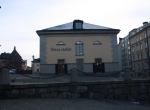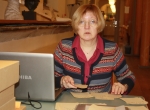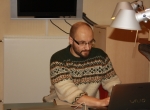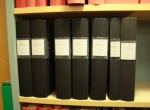A research visit to Sweden
2014.04.04 -
A recent assignment scheduled within the Maestro Project Migrations Period between Odra and Vistula Project took team members dr hab. Anna Bitner-Wróblewska and dr hab Bartosz Kontny on 6-16 February 2014 to the Riksantikvarieämbetet in Stockholm on an archival query of the legacy of Swedish researchers Bernhard Salin and Nils Åberg, major contributors to Migration Period studies. Bernhard Salin was the first to use the term Animal Style (in his fundamental study Die altgermanische Thierornamentik of 1904); characteristic for the Migration Period in Scandinavia, this style is noted outside this region, also on the territory of today’s Poland. In some of Salin’s notes and sketches (many of them of exceptionally high quality and admirable accuracy) we found a record (admittedly, rather modest) on archaeological objects once held by the museum in Königsberg, most notably, finds attributed to Dollkeim-Kovrovo Culture and Bogaczewo Culture and others, provenanced to the territory of Lithuania. The same group of papers was found to contain a rich body of data from Bernhard Salin’s tour of European museums – in Scandinavia, but also in Britain, Italy, France, Germany and Russia. The rather more extensive archive of Nils Åberg includes drawings of finds and redrawings made from publications; while their quality may be less excellent in some cases they are of great help in filling the gaps in the record of Migration Period grave assemblages from the territory of Balt settlement (Olsztyn Group in particular). Åberg took into account finds categories (e.g., lists of individual brooch and buckle types, etc.) dated to the Migration Period collected during a query made prior to the publication of his Ostpreussen in der Völkerwanderungszeit of 1919, a work still of major significance for Migration Period studies, and to some extent for the study of other periods of prehistory. Next to file cards with drawings and lists of archaeological objects this archive includes line drawings of finds made by Åberg as part of his extensive query of museums (in his lifetime Åberg visited more than 300 European museums), also in Poland (Poznań, Kraków, Toruń, the Erazm Majewski Museum in Warsaw, and others, during the interbellum period (1918-1939) and also during World War I. While this group of papers did not yield any unique finds datable to the Migration Period we found some valuable sketches of Stone Age finds (stone battle-axes in particular), held before the war by museums in Gdańsk and Szczecin (Stettin); with the Gdańsk collections sadly ravaged by World War II, this archive has the potential to be a valuable source for specialists in the Stone Age. It is also notable that Nils Åberg’s research field was broad, similarly as that of other archaeologists of his day (something that today, with the vast quantity of sources, is no longer practicable). One of his significant contributions was Typologie der nordischen Streitäxte (1918), written with Gustaf Kossinna. Also found among the Åberg papers is his private correspondence, some of it with fellow archaeologists (for instance, with the Polish prehistorian Włodzimierz Antoniewicz), and a relatively large group of private photographs. In sum, even if not fully original the investigated papers appear to be a significant source supplementing our understanding of the Migration Period in Poland; we expect to discover its full potential only in the course of further studies.
BK






